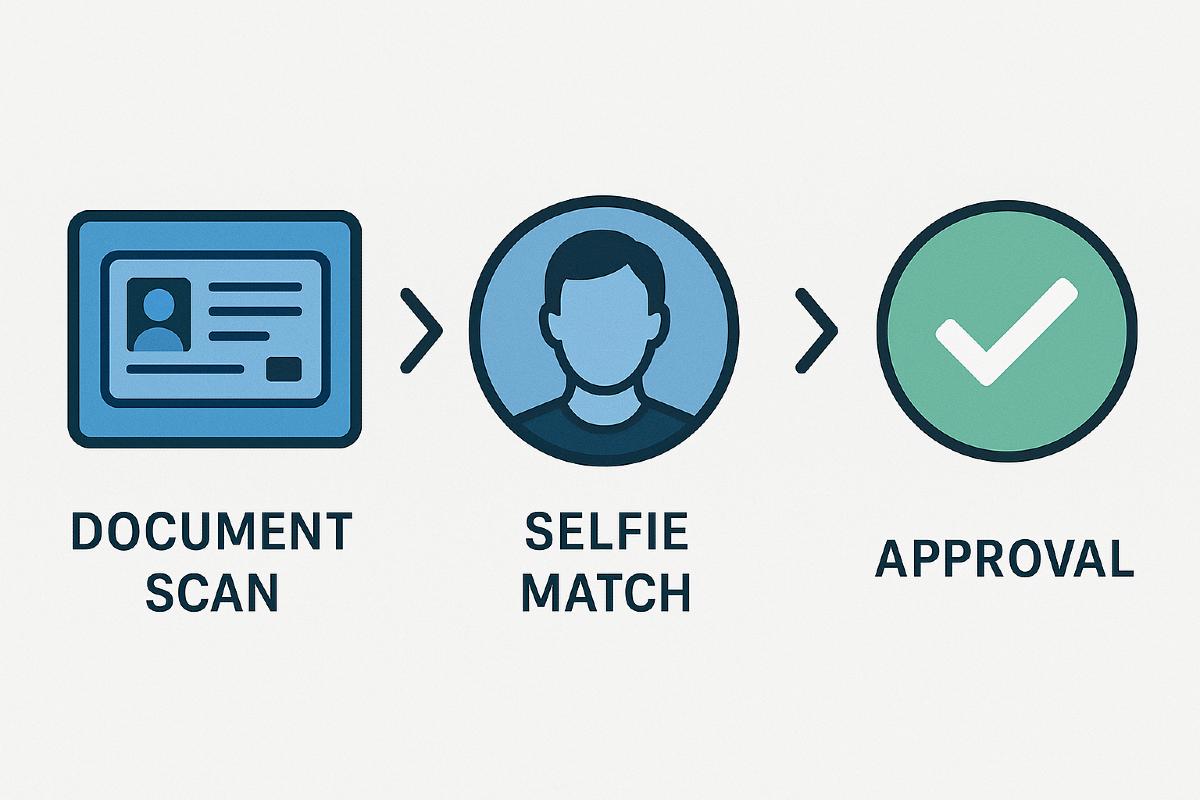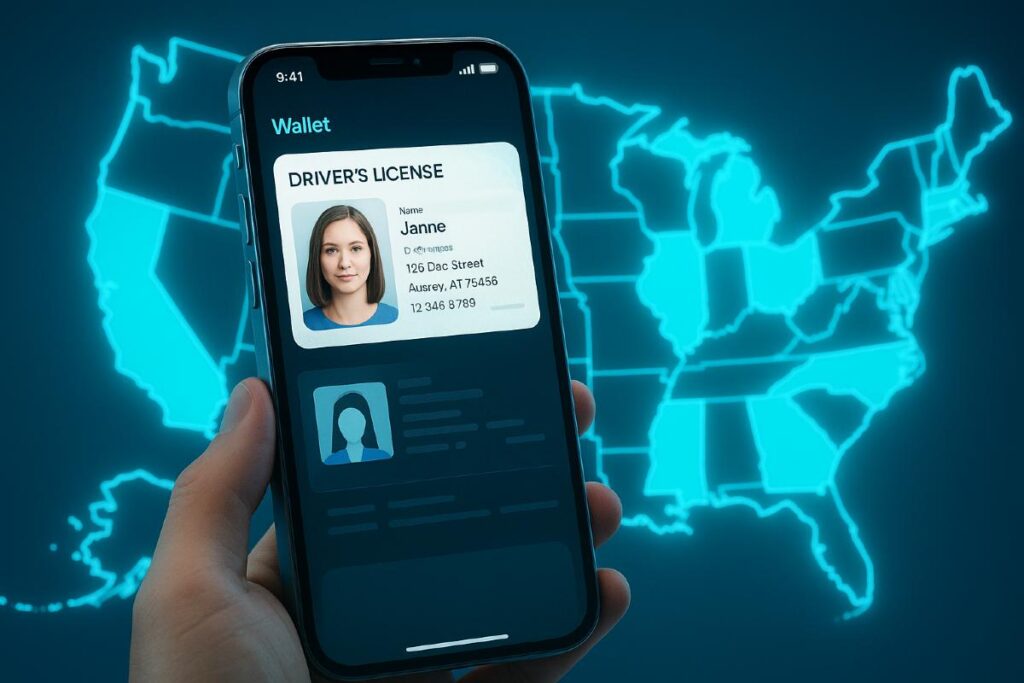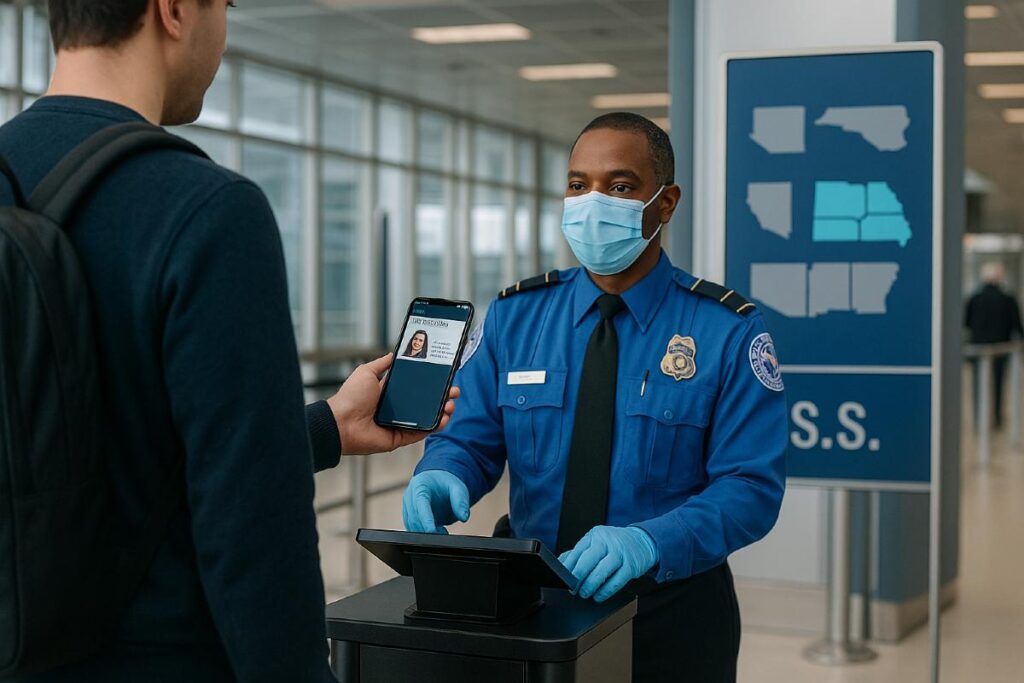
States With Digital ID Being Used Today
Digital IDs are growing faster across states, and there are now states with digital ID. More than 78 million Americans can now use digital IDs on their phones for domestic flights. This represents about one-third of the country’s licensed drivers. Fifteen states and Puerto Rico have rolled out digital driver’s licenses that let travelers verify their identity at airport security checkpoints.
Arizona, California, Colorado, Georgia, Hawaii, Iowa, Louisiana, Maryland, New York, Ohio, Utah, Virginia, and several other states have active mobile driver’s license programs. The adoption rate looks promising with five million Americans already signed up for digital credentials where these programs work between states. Travelers looking to use mobile licenses at airports should know that 14 states now give this option at airports with digital ID readers.
Digital IDs are changing everything in modern travel. The TSA continues to expand this technology across airports. Right now, 230 airports have Credential Authentication Technology (CAT-2) readers installed. This number will grow to 430 airports nationwide. But travelers need to remember that physical licenses are still needed in many places. This is especially true for international travel where digital verification systems are limited.
Contents
- 1 What is a Digital ID and How does It Work?
- 2 What States have a Digital ID in 2025?
- 3 Where are Digital IDs Accepted for Travel?
- 4 How TSA Uses Digital ID and Facial Recognition
- 5 What Travelers Need to Know before Using Digital ID
- 6 States with Digital ID Frequently Asked Question
- 6.1 Which States currently Accept Digital IDs at Airports?
- 6.2 How does a Digital ID Work for Travel?
- 6.3 Do I still Need to Carry My Physical ID when Using a Digital Version?
- 6.4 How is My Privacy Protected when Using a Digital ID at Airports?
- 6.5 Can International Travelers Use Digital IDs at U.S. Airports?
- 6.6 What Devices are Compatible with Digital IDs?
- 6.7 How do Airports Verify the Authenticity of a Digital ID?
- 6.8 Are Digital IDs Accepted Outside of Airports?
- 6.9 What Happens if My Phone Battery Dies and I Only Have a Digital ID?
- 6.10 How Soon Will Digital IDs Become Standard Across the U.S.?
What is a Digital ID and How does It Work?
Digital IDs work as electronic versions of physical identification documents. They offer a secure and convenient way to verify identity online and offline. These IDs consist of data points that uniquely identify a person or entity in the digital world. Read more about what digital identity is and isn’t.
Digital IDs let you verify your identity digitally without physical documents. This makes identity confirmation quicker and more efficient in services of all types. The services include government interactions, financial transactions, and air travel. Travelers need to understand how these digital credentials work to ensure smooth trips.

How Digital IDs are Stored on Phones
Your smartphone stores digital IDs with multiple security layers. State authorities issue these credentials directly to your device instead of cloud servers. This improves privacy protection by a lot.
People living in states with digital ID programs need to upload photos of their physical license (front and back). They must complete a biometric verification process. The process usually needs a short video or selfie matching their physical ID photo. The digital ID becomes available through a state app or digital wallet, based on the state’s system.
The Role of Apple Wallet, Google Wallet, and Samsung Wallet
Digital wallet platforms keep virtual identification cards safe in states with digital ID programs. Apple added digital ID support to Apple Wallet in 2021(see which states allow it). Google and Samsung later expanded their wallets to include official government identification.
Each platform works slightly differently but serves the same vital purpose – providing secure, authenticated identification. Google Wallet protects digital driver’s licenses with advanced encryption. Users can only access them with personal authentication. Samsung Wallet uses Samsung Knox security technology with fingerprint recognition and data encryption.
Your wallet options depend on your state. To cite an instance, Arizona supports Apple, Google, and Samsung wallets. Hawaii only supports Apple Wallet right now. You should check if your state has a digital ID that works with your device before using it to travel.
Biometric Security and Data Encryption
Digital IDs use strong security measures to protect your personal information. Biometric authentication stands out as the main security feature. It may include fingerprint scanning, facial recognition, or iris scanning to verify your identity.
On top of that, advanced encryption protects your digital ID data. The encryption uses two keys: a public key locks data, and a private key unlocks it. You can review the exact data being shared before showing your digital ID. This gives you more control over your personal information.
Digital IDs offer big advantages over physical ones if you lose your phone or someone steals it. You can erase your digital ID data remotely. This immediately invalidates the credential and stops unauthorized access. Travelers in states accepting digital ID can relax knowing no one can misuse their identification if their device gets compromised.
The list of states that accept digital ID keeps growing. More jurisdictions recognize these systems’ security benefits compared to traditional physical credentials.
What States have a Digital ID in 2025?
The digital world of identification is changing faster across America. More states now let their residents carry driver’s licenses on their phones. By mid-2025, digital IDs have become a big deal as millions of Americans can now choose to keep their identification on their mobile devices.
States with Active Digital ID Programs
Fourteen states and Puerto Rico have rolled out digital ID programs as of August 2025. Residents in Arizona, California, Colorado, Georgia, Hawaii, Iowa, Louisiana, Maryland, New York, Ohio, Utah, Virginia, and West Virginia can now get digital driver’s licenses.
Delaware and Mississippi have also created their own state apps for citizens. Public records show that about five million Americans have signed up for mobile driver’s licenses where these programs work between states.
Each state takes its own approach to digital IDs. States like Arizona, Colorado, Georgia, and Maryland work with Apple Wallet, Google Wallet, and Samsung Wallet. Louisiana takes a different path with its own LA Wallet app. Iowa gives its residents more options – they can use the state’s Mobile ID app or any major wallet platform.
States with Pilot or Planned Programs
The digital ID movement keeps growing. Several states are testing or getting ready to launch their programs. California tests its DMV Wallet App right now. Connecticut, Kentucky, Illinois, Indiana, New Mexico, North Carolina, Pennsylvania, and Washington D.C. plan to roll out mobile driver’s licenses soon.
North Carolina leads the charge with House Bill 199. The bill requires a detailed digital license system by July 1, 2025. This system will follow ISO/IEC 18013-5 standards for security, using encryption and biometric checks.
Some states hit roadblocks along the way. Oklahoma and Florida had to pause their mobile ID programs to make improvements. Missouri’s program is on hold too, though they haven’t said why.
How to Check If Your State Supports Digital ID
Your state’s Department of Motor Vehicles website is the quickest way to find out about digital ID options. These sites tell you everything about availability and how to apply.
Travelers should check the Transportation Security Administration’s website for a current list of states where digital IDs work at security checkpoints. The list shows which formats work – Apple Wallet, Google Wallet, Samsung Wallet, or state apps.
States like Colorado, Iowa, and Utah help their residents by listing places that take digital IDs on their websites. This helps people know where they can use their mobile credentials.
The American Association of Motor Vehicle Administrators tracks digital IDs across states. Their Digital Trust Service helps states verify each other’s mobile driver’s licenses, making it easier to use these IDs everywhere.
Where are Digital IDs Accepted for Travel?
The Transportation Security Administration (TSA) now accepts mobile identification at airports nationwide. Travelers from states with digital ID can use their electronic credentials at more than 250 TSA checkpoints by 2025. This transformation shows how travel verification procedures have evolved.
TSA Checkpoints with CAT-2 Readers
Credential Authentication Technology (CAT-2) systems are the foundations of digital ID acceptance. These advanced readers authenticate digital IDs and boarding passes while verifying Secure Flight pre-screening status through facial matching. TSA has deployed CAT-2 units at 160 airport locations across the U.S. The number will grow to over 220 locations by spring 2025.
The process works smoothly for travelers with state-approved digital IDs. Passengers tap their phone or smartwatch on the digital reader instead of showing a physical ID. The system captures an immediate image and matches it to the digital ID through facial recognition. The CAT-2 reader connects to TSA’s Secure Flight system, eliminating the need for a separate boarding pass.
Airports Currently Supporting Digital ID
Many major airports now accept digital IDs from participating states. John F. Kennedy (JFK), LaGuardia (LGA), Hartsfield-Jackson Atlanta (ATL), Los Angeles International (LAX), Denver International (DEN), and Ronald Reagan Washington National (DCA) lead this initiative. Smaller regional facilities like Syracuse Hancock International (SYR), Akron-Canton Airport (CAK), and Eastern Iowa Airport (CID) support this technology too.
Travelers should verify their state’s digital ID acceptance before relying on this option. Support varies by location, and not all airports have the right technology yet.
Why You still Need to Carry a Physical ID
TSA requires all travelers to carry physical identification documents whatever digital options exist. Technical glitches could prevent digital verification, and some situations might need physical document inspection.
TSA deletes travelers’ photos and personal data after identity verification. Passengers worried about privacy can skip the facial matching process and choose other ways to verify their identity.
How TSA Uses Digital ID and Facial Recognition
Technology at airport security checkpoints has transformed with facial recognition and digital ID verification systems. TSA now merges digital identity capabilities in states that have digital ID, mainly through the Credential Authentication Technology 2 (CAT-2) system.
How CAT-2 Readers Verify Identity
CAT-2 units make security stronger by matching travelers’ immediate photos with images stored on their digital IDs. Travelers tap their mobile device against the digital reader or scan a QR code from their device’s screen at checkpoints. They see an alert that shows what information TSA will receive and must agree before moving forward.
The system checks three vital things: the digital ID’s authenticity, matches ID details with flight bookings, and compares the current photo with the digital ID photo. Verified travelers can go through security without showing a physical boarding pass. TSA officers watch the process and do extra checks when needed.
What Data is Collected and Deleted
Privacy matters most for travelers from states with digital ID. TSA removes traveler data and images right after identity verification under normal conditions. These images stay private – not stored, shared, or used for law enforcement or surveillance.
Test environments work differently. TSA keeps photos and data briefly to review how well the technology works. The system changes this information into anonymous data, encrypts it, and sends it to the Department of Homeland Security Science & Technology Directorate. Most data disappears within 24 hours after scheduled flights, though some documents show deletion times up to 180 days or 24 months.
Opting Out of Facial Recognition
Travelers from states that have or accept digital ID can choose whether to use facial recognition. TSA makes it clear that anyone can say no to photos “without recourse”. Those who decline get their ID checked by a TSA officer instead, with no delays or problems.
You can opt out by telling the TSA officer you don’t want the scan and asking for manual ID verification. This choice won’t affect your place in line or lead to extra screening.
TSA keeps adding facial recognition at checkpoints in states with digital ID and plans to reach over 400 federalized airports soon. Signs at checkpoints tell people this technology remains optional, though some say these signs might be hard to spot.

What Travelers Need to Know before Using Digital ID
Digital ID usage for travel needs careful preparation as more states expand their programs. A good understanding of challenges and best practices will help you save time at security checkpoints.
Common Issues and Limitations
Technical glitches can still occur in states offering digital ID. Your digital verification might face disruption from power outages, system errors, or network problems. Many people lack smartphones or modern devices needed to store digital credentials. The situation becomes more complex for foreign nationals with work, student, or visitor visas since they cannot qualify for REAL ID-compliant digital identification.
Tips for Smooth Airport Check-in
Check your ID compliance well before your travel date. Set up your license in your phone’s wallet or state app before your trip. Note that states with digital ID programs might still ask you to carry physical identification as a backup. REAL ID enforcement starts May 7, 2025, and travelers without compliant IDs will need additional screening.
Security and Privacy Best Practices
Learn about the data collection and storage methods used with digital ID. Your participation in facial recognition remains optional in states accepting digital ID – you can opt out without any issues. Most states delete verification photos after the process completes.
States with Digital ID Frequently Asked Question
Which States currently Accept Digital IDs at Airports?
As of 2025, fifteen states and Puerto Rico have implemented digital driver’s licenses that can be used at airport security checkpoints. These include Arizona, California, Colorado, Georgia, Hawaii, Iowa, Louisiana, Maryland, New York, Ohio, Utah, and Virginia, among others.
How does a Digital ID Work for Travel?
Digital IDs are stored securely on smartphones and can be accessed through state-specific apps or digital wallets like Apple Wallet, Google Wallet, or Samsung Wallet. At equipped airports, travelers can tap their phone on a CAT-2 reader, which verifies their identity using facial recognition technology.
Do I still Need to Carry My Physical ID when Using a Digital Version?
Yes, the TSA still requires all travelers to carry their physical identification documents, even if they have a digital ID. This is necessary in case of technical issues or situations that require physical inspection of the ID.
How is My Privacy Protected when Using a Digital ID at Airports?
TSA immediately deletes traveler data and images after identity verification under normal circumstances. The process is voluntary, and travelers can opt out of facial recognition without consequences. Digital IDs also use encryption and device-level storage to protect personal information.
Can International Travelers Use Digital IDs at U.S. Airports?
Currently, digital IDs are primarily designed for domestic travel within the United States. Foreign nationals on work, student, or visitor visas are typically ineligible for REAL ID-compliant digital identification. International travelers should continue to use their physical passports and other required documentation.
What Devices are Compatible with Digital IDs?
Digital IDs can typically be stored on modern smartphones that support Apple Wallet, Google Wallet, or Samsung Wallet. Some states also provide their own dedicated apps for both iOS and Android devices.
How do Airports Verify the Authenticity of a Digital ID?
Airports use TSA-approved CAT-2 scanners that read the encrypted information stored in the digital ID. The system cross-checks the data with TSA’s database and often uses biometric verification for added security.
Are Digital IDs Accepted Outside of Airports?
In some states, digital IDs can be used for age verification at bars, restaurants, and retail stores. However, acceptance depends on local regulations and whether businesses are equipped with compatible verification technology.
What Happens if My Phone Battery Dies and I Only Have a Digital ID?
If your phone battery dies and you cannot access your digital ID, TSA will require your physical ID. This is why travelers are strongly advised to carry a backup physical identification document.
How Soon Will Digital IDs Become Standard Across the U.S.?
Widespread adoption depends on both state-level rollouts and federal integration. While more states are expected to introduce digital IDs over the next few years, experts believe full nationwide acceptance could take until the early 2030s.


